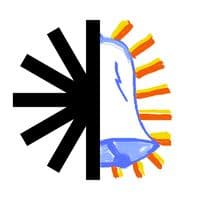The Call of Equinox
Reading AudaciouslyAmy L. Dalton
Published 21 September 2025

As the Southward Equinox, Peace Day and Sun Day align, we can experience a uniquely powerful call to align our inner equilibrium with the divine work of harmony in the world. In this Audacious Reading, CLBSJ Executive Director Amy L. Dalton reflects on this invitation in conversation with the first chapter of John’s gospel, and two anthems for justice and peace: “From a Distance” by Julie Gold and “Sumud” by Roger Waters.
Image: “Sun Day Art” by Liz Robinson, from sunday.earth/gallery
Christians often neglect the earth-centered holidays, despite the reality that much of our devotional calendar was literally built on top of them. There is a tendency to see this syncretism as in service of a sort of supersessionism whereby idolatrous “pagan” holidays were appropriately displaced by the growing Christian church. Exceptions like Unitarian (and Trinitarian) Universalism have for centuries tried to correct this attitude and focus on mining the significance of this syncretism: What biblical and theological content can we find within earth-centric traditions? I find that when we look in this way, we find a deep and brimming well.
Today, for example, is the eve of the Southward Equinox, when the sun traces a path directly over the equator. Following the Southward Equinox, those in the Northern Hemisphere will experience progressively less sunlight each day until the darkest day of the year, the Winter Solstice. Conversely, for those in the Southern Hemisphere, this Equinox marks the beginning of the season in which the length of sun per day is increasing. On the Equinox itself, there is a near balance between the experience of those in the north and south hemispheres.
In myriad traditions throughout the earth and over the millennia, the moment of the Equinox has been recognized as a day of spiritual significance because of this quality of balance. By cultivating conscious awareness of the earth’s experience of near-perfect equilibrium with reference to the star to which we are harnessed, it is thought that we can access a heightened awareness of the same balance and potential for balance within our bodies, minds and spirits.
For me, the Southward Equinox also offers a rich opportunity to reflect on the deep balance that exists between people across our diverse traditions and geographical settings, and to claim our role in cultivating that balance.
Often we do not feel this balance. The more normal experience is to feel the extreme nature of our imbalances — stark and painful disjunctures between the rich and the poor, the dark and the light, the right and the left, the members and the strangers. But as Julie Gold’s epic song (popularized by Bette Midler) narrates, from God’s perspective, these imbalances are not real. “From a distance, there is harmony! And it echoes through the land.”
Today and tomorrow, we have a special invitation to see ourselves the way God sees us, and in doing so to elevate our conscious intention to be part of the cultivation of that harmony.
Considering this, I don’t think it is an accident then that these very days have been days of deep significance for movements for social justice for many years.
- In one of the watershed moments in modern political history, the French Republicans, having abolished their monarchy on September 21, 1792, proclaimed September 22 as their “New Year’s Day.” The French Republican Calendar was in use from 1793 to 1805, and in tandem with the US Declaration of Independence, reshaped global expectations around the idea that governments could and should be controlled by the people who are subject to them.
- More recently, since 1981, the United Nations has recognized September 21 as “Peace Day,” a day for uplifting the yearning and call for ceasefire and disarmament. In it’s initial declaration, the UN General Assembly encouraged all people to use this day to set aside their differences and work towards a culture of peace. This year’s call to action focuses on learning about the UN’s Sustainable Development Goals, and how every person can participate in helping humanity reach them.
- For the past decade or so, environmental activists have also convened on September 21, in recognition of the link between the cultivation of peace between humans and the cultivation of a healthy relationship between humans and the earth as a whole. This year, that tradition is being continued by an effort called “Sun Day” in which Equinox Eve (which this year falls on Sunday) is claimed as a “Sun Day” to focus on the urgent need for solar energy technology. Everyone can connect with this effort by watching the short but powerful documentary, “The Light Won’t Dim,” which portrays the link between deep faith in God’s presence through difficulty, and the will to build human practices that reduce difficulty and bring ease to more people. Sun Day events are going on all over the world — find an event near you at sunday.earth – or create your own commemoration by participating in their call to draw a sun.
Taken together, these traditions represent a thread of human development which proceeds based on deep faith in the possibility that has been placed within humanity to steward this earth for the good of all and the harm of none. This faith is not just an identity that we lay claim to by uttering some variation of “Lord, Lord!” (Matthew 7:21), but it is an active faith that is forged by locating the part within us that contains divine knowledge and cultivating that. This is the precise process that is described in the first chapter of John, which the journey of the Word – otherwise translated, “Logos,” or “Reason” – is detailed. John testifies to how difficult it has been for this Word to be recognized within the human family, a reality which is still acute and painful. And yet John also testifies that this Word has indeed become flesh and has made it’s home among humanity. This writing captures deep awareness of the exact situation we are in — not by woefully overemphasizes the bad, and neither by blindly proclaiming that all is well when clearly it is not — but rather by soberly, stoically, devoutly naming the horror and the hope in balance.
It is only by attuning our mind to this balanced awareness that we can truly occupy our role as co-creators with God of harmony on earth.
Returning to Julie Gold’s anthem, the decision to unite one’s perspective with God’s view of humanity leads to deep clarity:
“From a distance, we are instruments
Marching in a common band
Playing songs of hope
Playing songs of peace
They’re the songs of every man!”
Roger Waters, co-founder of the bank Pink Floyd, recently produced a song in solidarity with the people of Palestine called “Sumud,” which taps into precisely the same stance:
“I just want that thing
When voices join in harmony
And in that fleeting moment
When meaning coalesces there
All dark dissolving
Clouds the alleyways no more…“
Both of these devotional songs, as well as so many others, capture in subtle balance the deep faith that we need to make it through with stark awareness of the difficulty ahead.
Today and tomorrow, let us respond to this invitation to unite with this call to rise above binaries and balance our inner awareness — and insodoing, balance our relationships with each other, our relationship with the earth, and our relationship with the great I Am. For at once, one and the same is fully true:
God is watching us – nothing is guaranteed.
And:
Reason will come of age, God will again dwell with humanity; we will turn this ship around!
I invite you to use the songs referenced in this reflection as devotional tools to respond to the Equinox’s invitation to the work of harmony:
